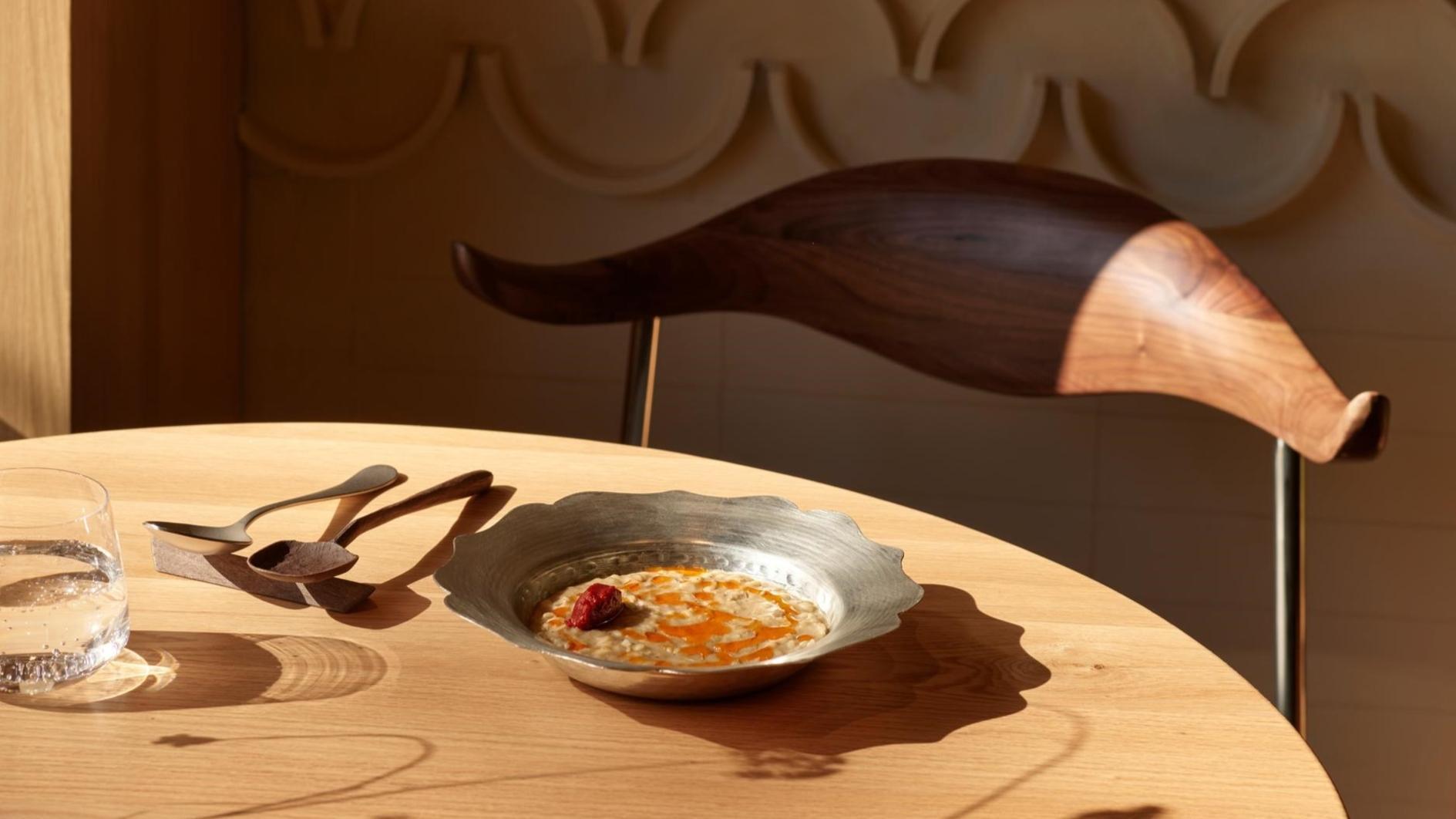
We were introduced to Asude and Bahadır at their tiny little restaurant, Herise, where they handled everything themselves, and we were impressed by their work. Their newly opened establishment is truly top-notch, from its exquisite decor to its meticulous service. Whether you try their keşkek (or kashkak) or Tire meatballs, every dish promises a memorable culinary experience that will linger on your taste buds.
We initially met them at their little venue on a street in Kızıltoprak. The restaurant, measuring just 28 square meters including the kitchen, could accommodate a maximum of 9 people at once, spread across three tables. They launched their business amidst the pandemic, which initially seemed challenging. However, their limited capacity proved advantageous as they primarily served closed groups of families and friends. They even delivered boxes of keşkek throughout the city when news of its health benefits spread during the pandemic. Keşkek, after which their restaurant Herise is named (Herise is also a type of keşkek), became their signature dish, loved not only for its hygiene but also its exceptional flavor. This demonstrated that people were truly hooked on Herise for its taste and safety alike.
They kept a low profile over the past year. Finally, last week, they announced the opening of their new location in Reşitpaşa. Eager to witness their highly anticipated innovations, I rushed to Herise during its initial days. Right from the start, let me clarify: Forget about the old Herise. No need to worry, though — I am not referring to the flavors; those remain unchanged in their distinctive style. On the contrary, they have elevated their standards significantly. From its décor to the smallest service details, Herise now embodies a world-class restaurant experience. Unlike its predecessor, the service here is tailored to individuals rather than catering to the entire table as a whole. They offer only one tasting menu, open for both lunch and dinner, accommodating up to 24 guests at a time.
While the predominance of light-colored, high-quality woodwork creates a Nordic-inspired atmosphere, the intricate details within and the service style reflect a meticulous Japanese aesthetic. For example, the two-tier bread box that greets you upon seating is a story in itself. Much of the restaurant's woodwork was crafted by designer Gökhan Eryaman, founder of the Haydanhuya brand. On the upper tier of the box sits a warm sourdough potato bazlama (a kind of flatbread), nestled among wheat grains, while the lower tier holds butter infused with mahaleb cherry, Tire's mud cheese, and Ezine's tomato paste. A stylish, gently curved wooden knife is neatly placed in a designated section of the lower tier, inviting you to spread these delicacies on the bazlama and enjoy them with satisfaction.
After the bread box, you will find dumplings made with cranberry tarhana, fine bulgur, and eggs. The eggplant with terebinth features grilled eggplants with garlic and olive oil, which is covered with dough prepared with terebinth powder, dried figs and walnuts. Söke yuvarlaması, a common dish cooked in Söke's households, features small dumplings of flour, ground beef, and spices, accompanied by a sauce of tomato tarhana over Söke's goat sausage. To cleanse the palate after Söke yuvarlaması, there is anise-infused raisin tzatziki served with roasted hemp seeds.
One dish that stood out for me on the menu was the Germencik sour chicken. This dish, rarely prepared nowadays, was passed down from a family in Germencik's Dağyeni Village. Chicken thighs and drumsticks are cooked with onions, tomatoes, and peppers, then topped with a tomato sauce infused with sour unripe grape juice, which is the defining characteristic of the dish. The intense sourness of the grape juice from Salihli is unique and hard to replicate elsewhere. If you have the chance, I suggest trying a spoonful of this sour unripe grape juice on its own to truly grasp its distinctive flavor.
The final two dishes are Tire meatballs and keşkek, which have been standouts since the restaurant first opened. The recipes for these dishes have remained unchanged. There have been slight adjustments in the presentation of Tire meatballs and the portion size has naturally been reduced since it is part of the tasting menu. When you enjoy the meatballs alongside the finely chopped piyaz (a type of bean salad) served on a separate plate, you might feel that these two dishes alone could sustain a restaurant. Keşkek, on the other hand, is made with marrowbone broth, wheat, and veal neck meat simmered together for six hours and then pounded traditionally with a wooden mallet to achieve its sticky texture. It is served in the authentic Tire style, accompanied by a dollop of tomato paste roasted in olive oil.
For dessert, you will find zerde (saffron and turmeric rice pudding), which is easily the best I have had recently, alongside gummy pudding, Arapgir halva, dark supangle and dried fig pulp in olive oil. The beverage selection features sirkencübin, a honey and vinegar sherbet, ayran with pickled hot peppers, elderflower soda and a refreshing cold green tea.
Asude and Bahadır categorize their restaurant as Anatolian cuisine. However, I suggest they focus specifically on the inner Aegean region, particularly Aydın, Söke, and Tire, where their expertise lies and where they define themselves. This approach would distinguish them more effectively from other establishments that offer local cuisine. They need not venture into extreme flavors because there are already a few places that excel at what they offer. In short, Herise has become a pride of our gastronomy. Oh, and Michelin certainly has a challenging decision this year...